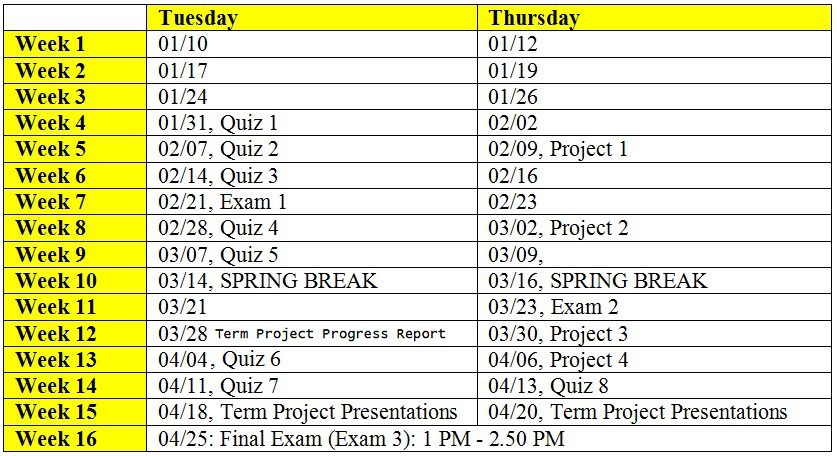Exam 3 (Final Exam): Take Home, Due on April 25th (1 PM to 3 PM) at ENB 275. Students need to submit the hard copy of the answers (printed out as instructed) along with the course survey at my office (ENB 275). I will be available at my office from 1 PM to 3 PM. Exams submitted after 3 PM on April 25th will NOT be accepted.
Quiz 7 on April 11th: Topics: Module 5 – Depth First Search (DFS): Undirected graphs and Directed graphs, including DAGs; Open Notes
Quiz 8 on April 13th: Theorem Proving Quiz (Closed Notes); Reading List
CSC323-Term Project Presentation Schedule-Sp2017
—————————————————–
Syllabus
Lecture Slides
Question Bank
Project Descriptions
Term Project
Quizzes and Exams
Code Tutorial
Dr. Meg's Desktop Selected Lecture Videos
Quiz, Exam and Project Schedules
—————————————————–
Syllabus
CSC 323, Spring 2017, Syllabus
Lecture Slides
Module 1: Algorithm Efficiency Analysis
Module 6: NP-Complete Problems and Heuristics
Question Bank
QB Module 1: Algorithm Efficiency Analysis
QB Module 2 – Classical Design Techniques
QB Module 4 – Dynamic Programming
QB Module 5 – Graph Theory Algorithms
Project Descriptions
Project 2 (Due: March 2, 1 PM)
Term Project
Quizzes and Exams
Exam 1 (Take Home; Due on Feb 21 @ 1 PM; hard copy in class)
Quiz 4 posted (Take home: Due on Feb. 28 @ 1 PM; hard copy in class)
Quiz 5 posted (Take home: Due on March 7 @ 1 PM; hard copy in class)
Exam 2 posted (Take home: Due on March 23 @ 1 PM; hard copy in class)
Quiz 6 posted (Take home: Due on April 4 @ 1 PM; Email me as instructed in the quiz description)
Code Tutorial
Dr. Meg's Desktop Selected Lecture Videos (YouTube Links)
Module 1: Analyzing the Efficiency of Algorithms
Time-Complexity analysis of a recursive algorithm to compute the factorial of an integer
Example for solving recurrence relations
Time-complexity analysis of an iterative algorithm to determine whether an array has unique elements
Decrease and Conquer – Insertion Sort Algorithm and Examples
Module 2: Classical Algorithm Design Techniuqes
Brute Force Algorithms QB – String Matching Problems
Divide and Conquer – Theorem-Proof: In order Traversal of a Binary Search Tree
Divide and Conquer – Master Theorem
Binary Search Algorithm and Examples
Comparison of Bottom-up and Top-down Approaches for Heap Construction
Transform and Conquer – Proof for Euclid's GCD Formula
Transform and Conquer – Heap Sort
Space-Time Tradeoffs for the Sorting Algorithms (Merge, Insertion and Heap Sorts)
Module 3: Greedy Technique
Greedy Technique – Fractional Knapsack Problem
Greedy Technique – Huffman Codes (Variable Length Prefix-free Encoding)
Module 4: Dynamic Programming
Dynamic Programming: Coin-row Problem Discussion and Example
Dynamic Programming: Binomial Coefficient
Dynamic Programming Solution for the Coin Collecting Problem in a Two-Dimensional Grid
Dynamic Programming: Integer Knapsack Problem (0-1 Knapsack Problem)
Module 5: Graph Theory Algorithms
Depth First Search on Directed Graph
Depth First Search and Articulation Points
Breadth First Search and 2-Colorability of Graphs
Topological Sort on DAGs and Proof for Neccessary and Sufficient Condition
Dijkstra's Algorithm for Shortest Path Trees and Proof for Correctness
Bellman-Ford Algorithm for Shortest Path Trees and Examples New!!
Kruskal's Algorithm: Examples to find Minimum Spanning Trees
Kruskal's Algorithm: Proof of Correctness
Properties (1 and 2) of Minimum Spanning Tree: IJ-Cut and Minimum Weight Edge
Prim's Algorithm for Minimum Spanning Trees and Proof for Correctness
Floyd's All Pairs Shortest Paths Algorithm
Part 1 Part 2 Part 3 Part 4 Part 5 Part 6 Part 7
Module 6: P, NP and NP-Complete Problems
Polynomial Reduction: Hamiltonian Circuit to Traveling Salesman Problem
Polynomial Reductions: Independent Set, Clique and Vertex Cover
Multi-fragment Heuristic for the Traveling Salesman Problem

